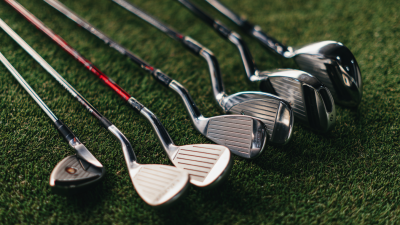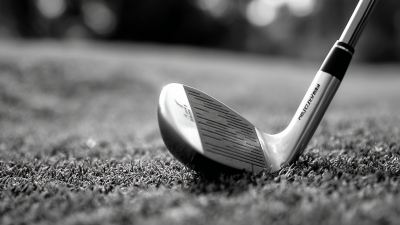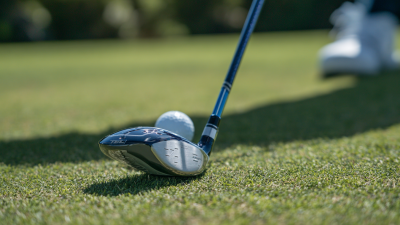The Ultimate Guide to Choosing Kids Golf Clubs for Young Golfing Enthusiasts
When it comes to introducing young enthusiasts to the game of golf, selecting the right equipment is crucial to fostering their passion and skill development. According to the National Golf Foundation, approximately 2.5 million kids aged 6 to 17 participated in golf-related activities in 2022, highlighting the growing interest among the younger generation. However, many parents find themselves overwhelmed by the variety of options available when it comes to kids golf clubs. Understanding the right specifications, such as club length and weight, can significantly impact a child's learning experience and overall enjoyment of the game. With a well-informed approach, families can ensure that their young golfers are equipped with the best tools to enhance their skills on the course, setting the foundation for a lifelong love of the sport.

Essential Factors to Consider When Selecting Kids Golf Clubs
When selecting kids golf clubs, several essential factors come into play to ensure a positive and effective introduction to the sport. First and foremost, the size and weight of the clubs are crucial. According to the USGA, junior clubs should ideally weigh about 20% less than standard adult clubs to accommodate young players’ developing strength. This allows children to swing with confidence while reducing the risk of injury. Additionally, club length should match the child's height and arm length; typically, children aged 5-7 should use clubs between 32-36 inches.
Another important factor is the club's design and material. Graphite shafts are preferred for younger golfers, as they are lighter and offer better flexibility, helping kids achieve greater distance and better control. Furthermore, clubs with larger clubheads can provide a larger sweet spot, making it easier for young golfers to make contact with the ball.
**Tips:** When purchasing clubs, consider a fitting session at a local golf shop to ensure the right size and weight. Also, look for junior sets that include a variety of clubs, such as drivers, irons, and putters, to allow for experimentation and skill development on the course.
The Ultimate Guide to Choosing Kids Golf Clubs for Young Golfing Enthusiasts
| Factor | Description | Recommended Age Group | Club Length (Inches) |
|---|---|---|---|
| Club Size | Selecting the appropriate size is crucial for comfort and performance. | 3-5 years | 30-32 |
| Weight | Lighter clubs are easier for kids to swing and control. | 6-8 years | 32-34 |
| Material | Different materials offer various levels of performance and durability. | 9-11 years | 34-36 |
| Flexibility | Flex helps in generating distance based on the swing speed of the child. | 12+ years | 36-38 |
| Grip Size | The right grip size ensures a secure hold and better control. | Multiple ages | Varies |
Understanding Different Types of Kids Golf Clubs and Their Uses
When selecting golf clubs for young enthusiasts, it's crucial to understand the different types available. Kids’ golf clubs generally come in three main categories: drivers, irons, and putters. Drivers are typically used for tee shots and help kids achieve greater distance off the tee with larger clubheads. Irons, which include various numbered clubs, are versatile and aid in various shots from the fairway and rough. Putters are essential for navigating greens and help young golfers develop precision in their short game.
Tips: When purchasing clubs, always consider the height and strength of the child. It's often best to opt for clubs specifically designed for kids as they are lighter and more appropriately sized. Additionally, ensure to check if the clubs have a larger sweet spot to promote better contact, thus fostering confidence in their abilities as they learn the game.
Another aspect to consider is the material of the clubs. Many junior sets come in either steel or graphite shafts, with graphite being lighter and easier for younger players to swing. However, steel shafts can offer more control as they grow older. As you shop, look for sets that allow for growth, either through adjustability or by being forgiving on mis-hits to keep the experience enjoyable for your aspiring golfer.

How to Measure Your Child's Height for the Perfect Club Length
When it comes to selecting the right golf clubs for young golfing enthusiasts, understanding how to properly measure your child's height for the perfect club length is crucial. Research indicates that junior golfers, who generally have less power and speed compared to adults, require equipment tailored specifically to their size and skill level. An ideal club length can significantly enhance a young player’s ability to swing effectively and develop proper technique. According to a recent analysis, mismatched equipment can hinder a child's progress and enjoyment, making it essential for parents to accurately assess their child's height.
To measure your child correctly, have them stand straight with their feet shoulder-width apart. Use a measuring tape to find the distance from the ground to their wrist when they are relaxed at their side. This measurement, combined with their overall height, will help you determine the appropriate club length. The standard guideline suggests that for every inch of height, a corresponding club length adjustment is necessary. By following expert recommendations and ensuring the correct fit, parents can support their child’s journey into the sport, setting a foundation for both comfort and skill development in their golfing endeavors.
Tips for Choosing the Right Material for Kids Golf Clubs
When selecting kids' golf clubs, the material plays a crucial role in ensuring a comfortable and effective golfing experience. Most children's clubs are made from a mix of lightweight materials, such as aluminum or composite plastics, which help in achieving the right balance between durability and ease of use. Aluminum, for instance, is an excellent choice for younger golfers as it minimizes the weight, allowing them to swing more freely and develop their technique without undue strain.
In addition to weight, the flexibility and feel of the material are essential considerations. Graphite shafts are often recommended for kids’ clubs as they provide a good level of flexibility while being lighter than steel. This flexibility can aid in generating clubhead speed and improving distance, which can be motivating for young players. Ultimately, choosing the right material not only enhances performance but can also make the game more enjoyable, encouraging kids to develop a lifelong passion for golf.
The Ultimate Guide to Choosing Kids Golf Clubs - Material Comparison
Guidelines for Picking the Appropriate Club Weight for Young Golfers
When selecting golf clubs for young golfers, one of the most critical aspects to consider is the appropriate club weight. Clubs that are too heavy can hinder a child's swing, leading to frustration and poor technique. It's essential to find clubs that allow them to swing freely and confidently.

Moreover, the length of the club also plays a significant role in how a young golfer can manage their swing. A club that's too long can be challenging for a child to control, affecting their ability to make effective contact with the ball.
Tips: To determine the right length, have the child stand upright and hold the club as they would when preparing to swing. The top of the grip should come up to their waist. Always ensure that the clubs are not only light enough but also correctly sized for their height and skill level, promoting better learning and enjoyment of the game.
Related Posts
-

Elevate Your Game with the Ultimate Golf Club Set for Every Skill Level
-

The Ultimate Guide to Choosing the Right Golf Club Set for Beginners
-

Mastering Your Short Game with the Best Golf Wedges for Every Skill Level
-

Unlocking Distance: How the 7 Wood Boosts Your Golf Game With a 20% Increase in Accuracy
-

Mastering the Greens Your Ultimate Guide to Choosing the Perfect Golf Set
-

Ultimate Guide to Choosing the Best Golf Travel Bags for Your Next Golf Adventure
